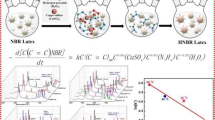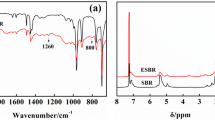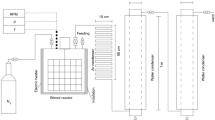Abstract
The thermal oxidation degradation of styrene–butadiene rubber (SBR) was investigated by in situ FTIR, 2D-FTIR, and programming heating DSC. The results of analyses suggest that the degradation reaction is an autocatalytic process and mainly occurs on the aliphatic part instead of benzene pendants. Based on the results of in situ FTIR and 2D-FTIR, the oxidation process can be divided into three stages. In stage one, just two carbonyl peaks appear, namely 1,697 cm−1 (conjugate carbonyls) and 1,727 cm−1 (saturated carbonyls), and the generation speed is 1,697 > 1,727 cm−1. Yet the peaks appearing at 1,777 cm−1 belonged to peresters and anhydrides generating in stages two and three. The generation sequences are: 1,698 > 1,727 > 1,777 cm−1 for stage two; and 1,698 < 1,727 < 1,777 cm−1 for stage three. According to DSC results, the thermal oxidation of SBR contains four steps. The first step is the generation of alkyl radicals and the accumulation of hydroperoxide species. The second step is initial oxidation stage mainly producing conjugate carbonyls. The third step is deep oxidation process generating diverse carbonyls. The fourth is chain termination reaction, in which step the generation rates of anhydrides and peresters are the fastest due to bi-radical termination of alkoxy radicals and the consumption of conjugate carbonyl. Furthermore, crosslinking reactions occur during the whole thermal oxidation.












Similar content being viewed by others
References
Allen NS, Edge M, Wilkinson A, Liauw CM, Mourelatou D, Barrio J, Martínez-Zaportab MA. Degradation and stabilisation of styrene-ethylene-butadiene-styrene (SEBS) block copolymer. Polym Degrad Stab. 2000;71:113–22.
Allen NS, Barcelona A, Edge M, Wilkinson A, Merchan CG, Santa Quiteria VR. Thermal and photooxidation of high styrene-butadiene copolymer (SBC). Polym Degrad Stab. 2004;86:11–23.
Munteanu SB, Brebu M, Vasile C. Thermal and thermo-oxidative behaviour of butadiene-styrene copolymers with different architectures. Polym Degrad Stab. 2005;89:501–12.
Schnabel W, Levchik GF, Wilkie CA, Jiang DD, Levchik SV. Thermal degradation of polystyrene, poly(1,4-butadiene) and copolymers of styrene and 1,4-butadiene irradiated under air or argon with 60Co-γ-rays. Polym Degrad Stab. 1999;63:365–75.
Jiang DD, Levchik GF, Levchik SV, Wilkie CA. Thermal decomposition of cross-linked polybutadiene and its copolymers. Polym Degrad Stab. 1999;68:387–94.
Saengsuwan S, Saikrasun S. Thermal stability of styrene-(ethylene butylene)-styrene-based elastomer composites modified by liquid crystalline polymer, clay, and carbon nanotube. J Therm Anal Calorim. 2012;110:1395–406.
Wang J, Cai X. Kinetics study of thermal oxidative degradation of ABS containing flame retardant components. J Therm Anal Calorim. 2012;107:725–32.
Arockiasamy A, Toghiani H, Oglesby D, Horstemeyer MF, Bouvard JL, King RL. TG–DSC–FTIR–MS study of gaseous compounds evolved during thermal decomposition of styrene-butadiene rubber. J Therm Anal Calorim. 2013;111:535–42.
Noda I. Generalized two-dimensional correlation method applicable to infrared, Raman, and other types of spectroscopy. Appl Spectrosc. 1993;47:1329–36.
Noda I, Dowrey AE, Marcott C, Story GM. Generalized two-dimensional correlation spectroscopy. Appl Spectrosc. 2000;54:236–48.
Noda I. Two-dimensional infrared spectroscopy. J Am Chem Soc. 1989;111:8116–8.
Eads CD, Noda I. Generalized correlation NMR spectroscopy. J Am Chem Soc. 2002;124:1111–8.
He Y, Wang GF, Cox J, Geng L. Two-dimensional fluorescence correlation spectroscopy with modulated excitation. Anal Chem. 2001;73:2302–9.
Jung YM, Czarnik-Matusewicz B, Ozaki Y. Two-dimensional infrared, two-dimensional raman, and two-dimensional infrared and Raman heterospectral correlation studies of secondary structure of β-Lactoglobulin in buffer solutions. J Phys Chem B. 2000;104:7812–7.
Chae B, Lee SW, Ree M, Jung YM, Kim SB. Photoreaction and molecular reorientation in a Nanoscaled film of poly(methyl 4-(methacryloyloxy)cinnamate) studied by two-dimensional FTIR and UV correlation spectroscopy. Langmuir. 2003;19:687–95.
2Dshige (c) Shigeaki Morita, Kwansei-Gakuin University, 2004-2005.
Mothé MG, Leite LFM, Mothé CG. Kinetic parameters of different asphalt binders by thermal analysis. J Therm Anal Calorim. 2011;106:679–84.
Mothé CG, Miranda IC. Study of kinetic parameters of thermal decomposition of bagasse and sugarcane straw using Friedman and Ozawa–Flynn–Wall isoconversional methods. J Therm Anal Calorim. 2013;113:497–505.
Friedman HL. New methods for evaluating kinetic parameters from thermal analysis data. J Polym Sci Part B. 1969;7:41–6.
Lui ZH, Tian SLZ. Thermal analysis. Handbook of analytical chemistry. Peking: Chemical Industrial Publications; 2000.
Piloyan GO, Ryabchikov ID, Novikova OS. Determination of activation energies of chemical reactions by differential thermal analysis. Nature. 1966;212:1229.
Rybińsk P, Janowska G, Kuberski S. Thermal properties of butaidiene–acrylonitrile rubbers. Polimery. 2003;48:183–7.
Janowska G, lusarski L. Thermal properties of cis-1,4-poly (butadiene). J Therm Anal Calorim. 2001;65:205–12.
Bottino FA, Pasquale GD, Fabbri E, Orestano A, Pollicino A. Influence of montmorillonite nano-dispersion on polystyrene photo-oxidation. Polym Degrad Stab. 2009;94:369–74.
Xu JB, Zhang AM, Zhou T, Cao XJ, Xie ZN. A study on thermal oxidation mechanism of styrene ebutadiene estyrene block copolymer (SBS). Polym Degrad Stab. 2007;92:1682–91.
Jubete E, Liauw CM, Jacobson K, Allen NS. Degradation of carboxylated styrene butadiene rubber based water born paints. Part 1: Effect of talc filler and titania pigment on UV stability. Polym Degrad Stab. 2007;92:1611–21.
Osawa Z, Nishimoto M, Otsuki H. Chemiluminescence from the isothermal oxidation of SBR and NBR elastomers. Polym Degrad Stab. 1997;57:69–75.
Yang QZ. Contemporary rubber technology. Peking: Sinopec Publications; 1997.
Wang SM, Chang JR, Tsiang RCC. Infrared studies of thermal oxidative degradation of polystyrene-block polybutadiene-block-polystyrene thermoplastic elastomers. Polym Degrad Stab. 1996;52:51–7.
Acknowledgements
This study is financially supported by the National Science Foundation of China (Grant No. 51133005).
Author information
Authors and Affiliations
Corresponding author
Rights and permissions
About this article
Cite this article
Guo, L., Huang, G., Zheng, J. et al. Thermal oxidative degradation of styrene-butadiene rubber (SBR) studied by 2D correlation analysis and kinetic analysis. J Therm Anal Calorim 115, 647–657 (2014). https://doi.org/10.1007/s10973-013-3348-0
Received:
Accepted:
Published:
Issue Date:
DOI: https://doi.org/10.1007/s10973-013-3348-0




